her-story of swimwear p.3
Women's swimwear fashion history
Hello, everyone! Hope you are well! This is the third installment of Ecce Homo’s blog series on
the fashion history of swimwear, and the second one dedicated especially to the
history of women’s swimwear! In
our latest article, we set off on an amazing journey following the development of swimwear designed for women from the Ancient Times all the way to the early 20th century. The history of swimwear was also an occasion to visit the history of swimming itself, while we acquired quite a perspective on the history of gender and sexuality throughout the decades. This would be also the case in this blog article that traces the fashion history of bathing suits since the 20s along with the major historical developments of the feminist movement. If the 1910s was the decade of the first wave of feminism in the UK, the 1960s and the 1970s saw the rise of
the second wave of feminism in the USA, but the truth is that both of these important sociopolitical events have changed the course of swimwear history in ways we are about to see. Who would have thought that one could learn about the history of feminism by taking a close look at the history of swimwear? This detour also serves as an important caveat regarding the highly gendered terms in which the history of fashion is written. Even though we wholeheartedly embrace a non-binary and gender-less approach to fashion -
our latest swimwear collection RetroWaves is a living testament to this-, all the historical resources we were able to put our hands on were mediated by a strict gender binary that up to a point mirrors the conceptualization of gender of the time that they refer to. On top of that, these accounts were extremely limited in their geographical scope and focused exclusively on swimwear designed having in mind mostly the white, middle-class, and heterosexual women of the USA and the UK as customers.
Having cleared things up, let’s move forward to the 1920s and 1930s when bathing suits were upgraded with decorative elements and became more figure-hugging thanks to the introduction of new fabrics such as latex and nylon. In terms of body coverage, the arms were left completely exposed, as shoulder straps became a standard, while the legs were cut really high as suntanning was made fashionable by Coco Chanel! During this time, the California-based women’s swimwear brand Catalina introduced a series of bold and sexy designs, among them bare-back ones, by appealing to the popularity of Hollywood actresses for its marketing campaigns. In 1935, American designer Claire McCardell designed a bathing suit that is considered to be bikini's forerunner, while three year later, the Telescopic Watersuit made of elastic cotton was introduced as a revolution in terms of fabric technology. Cotton sun-tops were also a thing. Fun fact: in 1939, the Million Dollar Mermaid movie, a biopic of Kellerman, hit the theaters starring Esther Williams, an Amateur Athletic Union champion.
The following decade, the 1940s, could be characterized by one word: bikini! And one of the reasons that gave birth to this iconic piece of swimwear is none other than the War World II itself and the enormous amount of resources that the war machine required in order to sustain itself and which led to a serious shortage of material, among them fabrics. In the USA, the government had to intervene into the textile production by imposing restrictions on the use of natural fibers in clothing, such as cotton, wool, rubber, and leather. In order for the swimwear manufacturers to respond to the demand of the era, they had to design a new type of bathing suit using the least fabric they could, and in the case of bikini, this meant leaving the midriff exposed, a trend present in the previous decades only sporadically. This new swimsuit was a two-piece bikini comprised of a bra-like top and a short bottom enabling swimwear brands to keep up with the wartime rationing of fabrics and pushing towards more body-positive representation of the female figure with its form-fitting characteristics and the unprecedented degree of skin exposure. In fact, bikini was initially embraced by women in Europe and then became a trend in the more conservative at the time USA thanks to its endorsement by Hollywood stars, such as Marilyn Monroe and Laure Turner, even though it was Brigitte Bardot who is credited with bikini getting mainstream in the 1950s. This is no accident as the first ever bikini -named after the atomic tests at Bikini Atoll- seems to be designed in 1946 by French fashion designer Louis Reard who had a hard time finding a model for his creation as it was considered to be too revealing. However, according to some accounts, it was Jacques Heim, a French fashion designer, who created earlier the same year the bikini called Atome. Notice how the discourse of atomic warfare that dominated the 40s was reappropriated so soon by these two designers for marketing purposes despite former’s mass destructive effect.
Along with the bikini, the 1950s saw the rise of one-piece structured ‘corsetry’ swimsuits designed to accentuate the ‘right’ curves of a woman’s body by incorporating boning in the bodice, much like a corset, and creating a Merilyn Monroe-like figure with a flat belly, slim waist, and an impressive bust, a regression in terms of women’s liberation if you ask me. In other words, bikini’s reception was gradual, and it took quite some time for it to become an everyday piece of swimwear for the majority of women as its ban from many beauty pageants and fashion magazine of the era testifies. According to Vogue magazine, it was during the 50s that swimwear started signifying a ‘state of dress, not undress’ pointing towards a radical change in morals regarding clothing and nudity. The developments in fabric technology had also a positive effect on the popularization of bikini as polyester, lastex, and acrylic all have qualities fitting for swimwear. We should also keep in mind that this was the golden era of Hollywood with its immense cultural influence in the context of which the notion of sex symbol was created. Furthermore, the post-war years saw the popularization of beachwear and resort style as a distinct and sizable marketing category. Bring in mind Christian Dior’s floral swimwear collection of the time! Around the same time, the first Speedo made of elastic nylon was created and widely worn at competitive swimming events initially by men and then by women too.
The 1960s was more or less an uneventful decade. Swimsuits became more stylish by introducing color, patterns, and prints. Among the trends of the decade, the following three seem to stand apart. Firstly, swimsuits with polka dot patterns were a huge hit thanks to the polka dot mania ignited by the popular song ‘Itsy Bitsy Teeny Weeny Yellow Polka Dot Bikini’. Secondly, a type of bikini with bottoms that hugged the hips and a baby doll top was a sensation for some years. And last but not least, the topless monokini, a design of 1964 by Rudi Gernreich, consisting of a bottom that extended from the midriff to the upper thigh held up by a thin strap that made a halter around the neck. This totally impractical piece of swimwear was a protest against the ban of nudism in the State of California and a powerful statement of defiance against body policing. Another important development was the introduction of shiny fabrics, such as lycra/spandex/elastane, that spiced things up, and the entrance of huge fashion houses, such as Giorgio Armani and Calvin Klein, into the swimwear market with ready-to-wear collections.
And then it was the 1970s during which swimsuits became smaller and smaller! But an important historical development had been under its way already since the 1960s culminating in the 1970s in a sort of a cultural and social revolution set to question decade-long implicit assumptions about social roles and power imbalance! Yes, you guessed right, it was the time of the second wave of feminism that could not but influence the course of the history of fashion. Initially located in the USA in the heated political context of the anti-war, counterculture, abolition, and civil rights movements, this social movement also known as the women’s liberation movement soon spread throughout the world. Sprung out of the so-called conscious-raising groups that brought together everyday women in a safe space that provided them with the opportunity to discuss freely their challenges that they were facing due to their gender in a patriarchal society, these activists soon realized that their personal experiences and problems were shared by many other women, that rather than constituting individual cases, these were actually the manifestations of deep social and political structures that permeated the American society. However, the second wave of feminism differs significantly from the abovementioned first wave in terms of its political philosophy and its political claims. In particular, this movement had a much broader activist agenda that included reproductive rights, such as the right to contraception and the right to abortion, gender-based violence, especially domestic violence and marital rape, and sexuality, like the role of pornography in relation to women’s status, among others.
When it comes to its political and social tenets, the existential philosophical treatise The Second Sex by Simone de Beauvoir, published in France in 1949, set in motion a totally new way of thinking about gender. The famous quote ‘one is not born a woman, but becomes one’ was one of the first theorizations of the social construction theory of gender, the theory that maintains that gender is a historically situated and social specific construction, something changeable over time and across space that has nothing to do with an eternal essence in terms of either body or psyche. Second wave feminists drew from this insight the conclusion that if womanhood is anything but natural, then it follows that patriarchy itself is a contingent sociopolitical regime and not the natural order of things. To put it simply, things can change! This was ‘a women’s liberation movement’ that paradoxically put into question each and every term of this phrase. Womanhood is both a social construct and the subject of political mobilization. But who is the woman that one is talking about? Especially in the 1970s, an internal criticism was put forward against the mainstream feminism movement from all those ‘women’ on the fringes of womanhood represented by the movement, namely the black and indigenous feminists and the lesbian feminists, among others. The while middle-class American heterosexual feminism was under attack and this led to the realization that not only women are different from men, but also the very woman is split. If the first wave put forward its claim on the basis of the sameness of women with men, the second wave not only based its claims on the gender difference between men and women, but it took things further towards an intersectional approach that is based on the internally differentiated notion of womanhood. Even the term liberation was a political question since the second wave aimed at a radical reformation of society and not at a limited set of legal rights as the first wave did.
Having said that, let’s get back to the fashion history of swimwear! In the 1970s, women’s liberation inevitably led to more revealing bathing suits as a statement of women’s defiance of patriarchal dress codes meant to police their bodies. As a result, string bikinis, think thongs, and thong-like bottoms became the standard beach attire introduced by the fashion designer Rudi Gernreich, the creator of monokini as we saw above. An iconic image of this decade was the super sexy red tank suit worn by Farrah Fawcett at a 1976 poster!
The 1980s saw the rise of plunging suits that went viral for quite some time, but it was the over-the-top styling of the bathing suits that characterizes this decade more than anything else. Neon colors, animal prints, color blocking, and fancy patterns were stealing the spotlight! But the 80s was also the decade of super-modeling and the leg mania that the later gave birth, which was translated into really high leg cutouts. In addition, mix and match was a trend with women combining different tops and bottoms in order to create their unique looks and the first sun protecting fabrics were introduced into the market. It was in 1985 that Rudi Gernreich created his last bathing suit design, the lesser known but equally provocative pubikini, a tiny V-shaped fabric covering the hips and buttocks but leaving exposed the pubic hair.
This leads us to the 1990s and the immense influence the television show Baywatch, running from 1989 to 2001, had on women’s swimwear fashion! The Brazilian beachwear frenzy came along with tangas, thongs, tie bikini bottoms, and super tiny triangle tops! The athletic style -closely affiliated with the surf culture and the californication mania- was the style of the decade, while shiny red was the color to wear! Tank-top necklines, high-cut legs, mix-and-matching and one-pieces were really trending, but the innovation of the decade was the tankini designed by Anne Cole in the late 90s which was an immediate success. This was a bathing suit that combined a tank top, mostly made of spandex-and-cotton or Lycra-and-nylon, and a bikini bottom, a piece of swimwear somewhere in between a bikini and a one-piece in terms of both modesty and practicality that continued to dominate in the 2000s. Just bring in mind Victoria’s Secret’s and Nike’s swimwear campaigns in 2005 in which tankinis were a major feature. The 2000s also saw many styles of previous decades making a come-back, while swimwear fashion seemed to become more inclusive in terms of sizing. Finally, mini bikinis were perhaps the new norm with pareos complimenting the beach style.
Based on information from:
https://www.ocf.berkeley.edu/~roseying/ids110/WHIS.HTM
https://lifestyle.howstuffworks.com/style/fashion/trends-looks/history-of-womens-bathing-suits.htm#pt5
https://glitzglamandrebellion.com/blogs/news/the-evolution-of-womens-swimwear-from-the-1700s-to-today
https://www.swimmingpool.com/blog/swimsuits-throughout-history/
https://en.wikipedia.org/wiki/History_of_swimwear
https://fashionhistory.fitnyc.edu/a-history-of-womens-swimwear/
https://irvettaswim.com/blogs/news/the-evolution-of-swimwear





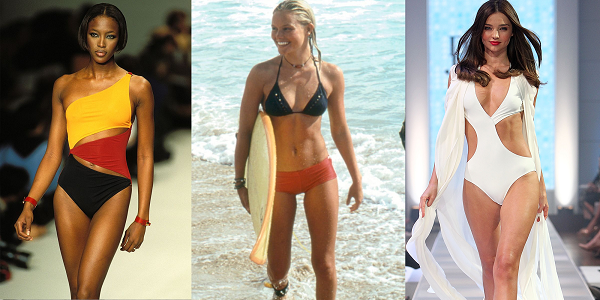

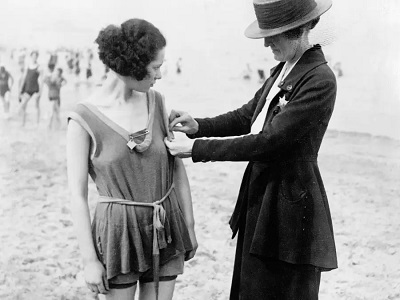

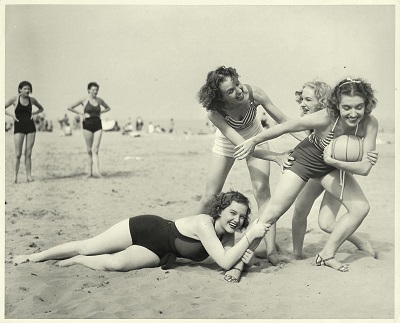
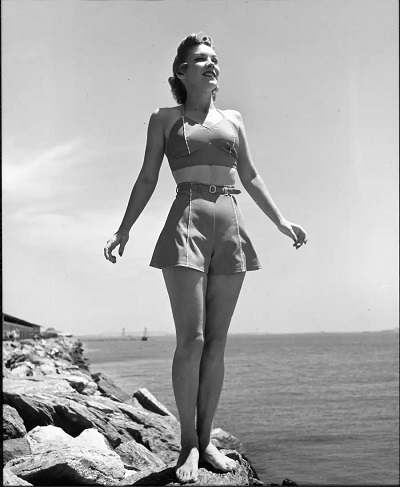
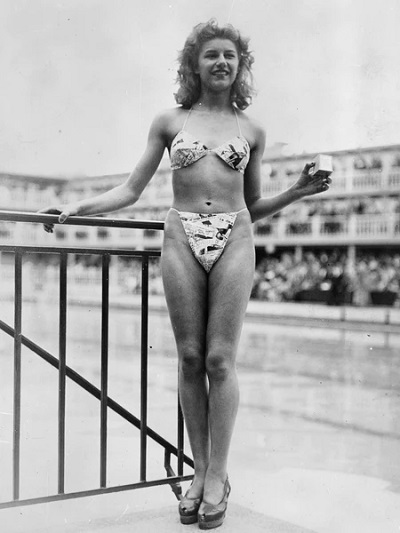

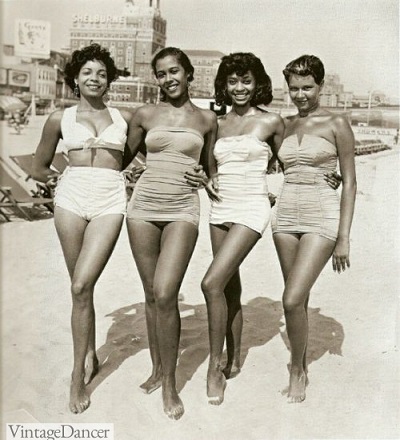


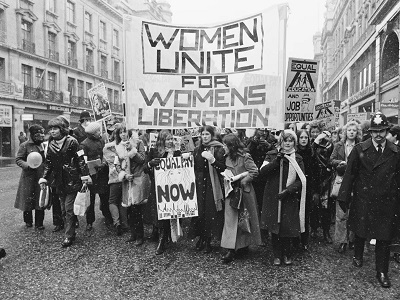

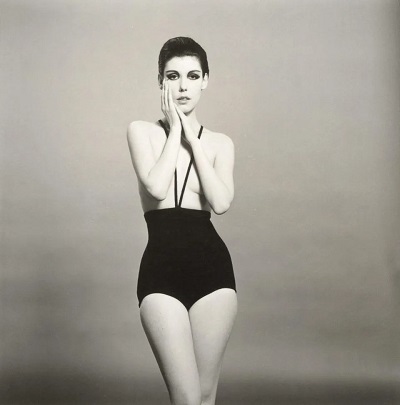

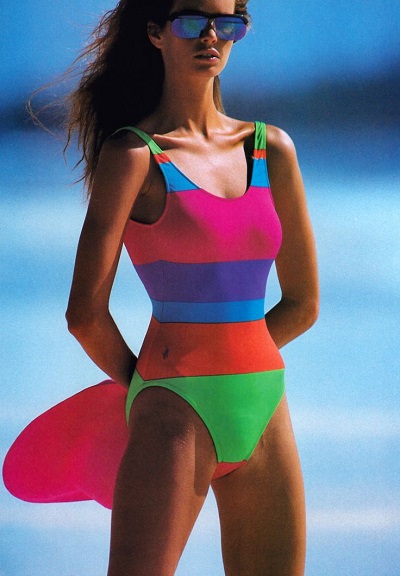
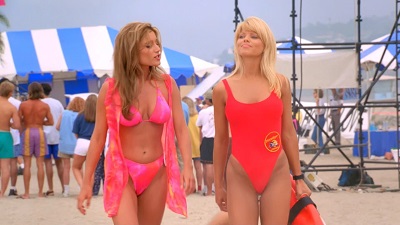


 Login
Login